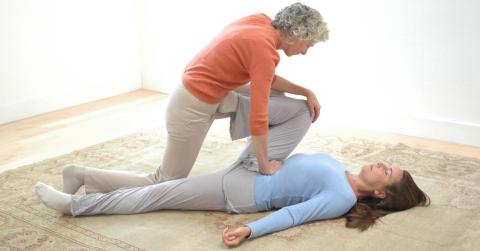
To the extent that one can do bodywork over the phone, I recently experienced a Breema treatment. It was just lovely. I haven't had the good fortune to experience a hands-on Breema session, and in fact, I only learned about this form of bodywork a few months ago. But as I listened to Jon Schreiber, D.C., director of the Breema Center, describe Breema and the philosophy behind it, I was so transfixed that I felt differentand better – in my body after our conversation. Despite sitting in my typical "interview slouch" posture, I felt a little lighter, taller, and more at ease at the end of the call.
WHAT IS BREEMA?
Visually, Breema somewhat resembles Thai yoga massage, although Breema's movements, rhythms, and sequences are quite unktue. The recipient lies on the floor fully clothed while the practitioner uses her body to give soothing stretches, a gentle yet fum touch to nurture, and rocking motions to create a sense of ease. There are many stretches, exercises, and sequences of movements in Breema, and practitioners choose whichever seem appropriate based on nine principles of harmony. These principles, such as "body comfortable" and "no hurry/no pause," are deliciously self explanatory (see sidebar). Schreiber describes them as "the art of being present."
Breema began in the 1980s when Schreiber completed his chiropractic training and wasn't satisfied with starting a traditional practice. He found a group of eight like-minded colleagues to create the nine principles. The bodywork is merely a vehicle for embodying and expressing the principles – which may explain why I felt I'd had a little Breema experience on the phone with Schreiber. Breema bodyworkers practice the principles in their daily lives to help raise their own awareness of and connection between mind, body, and feelings. During a session, the practitioner embodies and conveys Breema's principles through touch and vibe. Laura Rose Boyle, a Breema practitioner and massage therapist in Chicago, explains it like this: "Breema is a meditation practice that I do, and the recipient is there to support me in being really present. I'm not working at giving a treatment so much as I am simply sensing the body according to the principles, and through my touch and gentle stretches, I convey a sense of reassurance. It's quite magical."
IT'S All OKAY
As long as you're alive, Schreiber says, there is something more vital and healthy about you than all of your imbalances and illnesses. That's the foundation of the reassurance conveyed from practitioner to recipient.
"Whatever the recipients' condition, the underlying thing constantly communicated to them – not necessarily verbally but in the quality of touch – is the message 'You're okay,"' Schreiber says. ''This essential reassurance allows the recipient to let go of a lot of anxiety and fear."
The body's reaction to anxiety and fear is to restrict blood .flow and to compromise breath, neither of which promotes healing or well-being. And while Breema is not intended to cure what ails you, the experience of being put at ease often transforms the relationship with pain, disease, and other discomforts.
The sweetness of a Breema treatment comes when recipients sense – whether cognitively, physically, or emotionally – that their practitioners view them not as a body with a backache or, say, an arm that won't fully extend, but as being whole and okay as is. "That absence of criticism," Schreiber says, "for many people, is the first moment in their life, even when surrounded by people who love them, that there is no unspoken pressure to be something other than what they are. Breema's underlying belief is that however you are in this moment should be met with full acceptance."
Of course, growth and change have a place in the world of Breema. But that comes from the Breema recipient, not the practitioner. Change may come when the recipient realizes she no longer needs her "armoring," or psychological protection. And when she lets that go, Schreiber says, she can experience a deeper connection to her "essential aspect,'' that pure, spiritual core in each of us. "That helps a person connect a little bit to a greater potential where [he or she] can feel that life has a different possibility and a purpose. And that is a wonderful thing."
9 PRINCIPLES OF HARMONY
Here are the principles that Breema practitioners cultivate in their daily lives and share, through touch, during a session of bodywork. To find a practitioner in your area, go to breema.com.
BODY COMFORTABLE – When we look at the body, not as something separate, but as an aspect of a unified whole, there is no place for discomfort.
NO EXTRA – To express our True nature, nothing extra is needed.
FIRMNESS AND GENTLENESS – Real firmness is always gentle. Real gentleness is always firm. When we are present, we naturally manifest firmness and gentleness simultaneously.
FULL PARTICIPATION – The most natural way of moving and living is with full participation. Full participation is possible when body, mind, and feelings are united in a common aim.
MUTUAL SUPPORT – The more our Being participates, the more we are able to support life and recognize that Existence supports us. Giving and receiving support take place simultaneously.
NO JUDGMENT – The atmosphere of nonjudgment gives us a taste of acceptance of ourselves as we are In the moment. When we come to the present, we are free from judgment.
SINGLE MOMENT/SINGLE ACTIVITY – Each moment is new, fresh, totally alive. Each moment is an expression of our True nature, complete by itself.
NO HURRY/NO PAUSE – In the natural rhythm of life energy, there is no hurry and no pause.
NO FORCE – When we let go of assumptions of separation, we let go of force.
Excerpted from Breema and the Nine Principles of Harmony, by Jon Schreiber
*Practicing Presence through Breema was written by Jennifer Derryberry Mann and originally published in Spirituality and Health.
